Efficacy of Seed Priming Technique on Seed Germination and Plant Growth Under Salt Stress in Oryza sativa
1
Department of Botany,
University of Delhi,
New Delhi
India
Corresponding author Email: rsisodia@maitreyi.du.ac.in
DOI: http://dx.doi.org/10.12944/CWE.18.2.20
Copy the following to cite this article:
Garg V, Chauhan N, Chauhan S, Mallick I, Sharma S, Sisodia R. Efficacy of Seed Priming Technique on Seed Germination and Plant Growth Under Salt Stress in Oryza sativa. Curr World Environ 2023;18(2). DOI:http://dx.doi.org/10.12944/CWE.18.2.20
Copy the following to cite this URL:
Garg V, Chauhan N, Chauhan S, Mallick I, Sharma S, Sisodia R. Efficacy of Seed Priming Technique on Seed Germination and Plant Growth Under Salt Stress in Oryza sativa. Curr World Environ 2023;18(2).
Download article (pdf)
Citation Manager
Publish History
Select type of program for download
| Endnote EndNote format (Mac & Win) | |
| Reference Manager Ris format (Win only) | |
| Procite Ris format (Win only) | |
| Medlars Format | |
| RefWorks Format RefWorks format (Mac & Win) | |
| BibTex Format BibTex format (Mac & Win) |
Article Publishing History
| Received: | 2023-03-30 |
|---|---|
| Accepted: | 2023-07-17 |
| Reviewed by: | 
 Aleksandar Racz
Aleksandar Racz
|
| Second Review by: |

 Kannan Warrier
Kannan Warrier
|
| Final Approval by: | Dr R K Aggarwal |
Introduction
Plant productivity is known to be severely compromised by soil salinity1. Around 190 million hectares of irrigated land have already been lost to salt and are no longer suitable for farming, according to a report by the Intergovernmental Science-Policy Platform on Biodiversity and Ecosystem Services2. India faces a similar issue with soil salinity affecting major agricultural states like Gujarat (2.23 M ha), Uttar Pradesh (1.37 M ha), Maharashtra (0.16 M ha), West Bengal (0.44 M ha) and Rajasthan (0.38 M ha).Collectively, these states account for 75% of the saline soil of the 6.73 million hectares of affected land in India3.
Oryza sativa L. a widely grown tropical cereals is increasingly being threatened by rising levels of salt. Rise in sea levels and frequent flooding has led to salt intrusion into fresh inland water. Additionally, the use of salted water for irrigation in rice adversely affects plant growth and subsequent crop yield4. Pusa Basmati (PB) an indigenously developed variety of rice through breeding is one of the most preferred rice varieties. It is coveted for its grain attributes and aroma. The PB cultivars 1121 and 1718 have been developed for improved resistance against several bacterial diseases5. However, their ability to sustain salinity stress is not known. In rice seed germination is severely affected by salinity impairing seedling establishment and growth6. Breeding of salt tolerant cultivars and the development of technologies that enable efficient seed germination is the key to ensuring high yield7, 8.
Seed priming technology offers the possibility of enhancing seed germination and crop productivity9. It is one of the most promising pre-sowing seed treatments to boost crop output under stressful conditions and is one of the efficient procedures for micronutrient administration during planting in field crops10,11. Seed priming facilitates quicker germination in plants under abiotic stress by induction of protective cellular and metabolic events thus facilitating speedy emergence and uniform stand establishment of seedlings which eventually enhances the crop productivity12. Various priming treatments like hydropriming, PGR-based (plant growth regulators) hormonal priming, osmopriming, organic priming and chemical priming are used to increase the resilience of crop plants towards various abiotic stresses13-16. The effect of seed priming methods on mitigating abiotic stress has been well documented on various plants like Zea mays, Vigna radiata, Triticum sp, and Oryza sativa 17-19. In this study, selected organic, chemical and hormonal primers have been tested for their efficacy in promoting seed germination and growth in Oryza sativa Pusa Basmati cultivars PB 1121 and PB 1718 under salt stress.
Materials and Methods
Procurement of plant material
Seeds of Oryza sativa var. Pusa Basmati (cultivars PB 1121 and PB 1718) were procured from Seed Bank, IARI, New Delhi, India. The seeds were washed with a mild detergent, rinsed thoroughly with water and treated with various priming agents for 24 hours at room temperature. Seed priming treatments were given in a randomized manner with three replicates per treatment. The primers used in the study were:
Organic Priming- Cow urine (2%), Moringa leaf extract (MLE; 100%), Neem leaf extract (NLE; 50%)
Chemical Priming- NaCl (100 mM), KNO3 (1 %), MgSO4 (10 mM)
Hormones- Salicylic Acid (1 mM),
Amino acid- Proline (50 mM)
The concentrations of seed priming agents used in this study were based on the published reports. The seeds were washed thoroughly in water, air dried for 24 hrs and stored till further use. The primed seeds were subjected to salt stress by exposure to 150 mM NaCl for 24 hrs. All the experiments were performed in triplicates.
Estimation of germination parameter
The seed germination parameters were assessed using the following formulas:
Germination percentage (GP) =(N1/N2) × 100
N1 = number of germinated seeds
N2 = total number of seeds
Mean daily germination (MDG) = Final GP/ number of days to reach final GP
Peak value (PV) = Final GP/ number of days required to reach the peak value of the germination
Germination value = PV × MDG
Germination energy percentage = (Number of seeds germinated at 2 days after sowing / total number of the seeds tested) × 100
Estimation of growth parameter
Using a thread and a scale the shoot length was measured from the tip of the growing shoot to the base of the cotyledons. Similarly, for root length the length from tip of the growing root to the base of cotyledons was measured.
Biochemical analysis
For biochemical analysis total protein content was assessed spectrophotometrically by using Lowry’s method20, total phenolics content using Folin-Ciocalteu method21,22 and antioxidant levels using 1, Diphenyl 2- Picryl Hydrazyl (DPPH) assay23.
Statistical Analysis
Control and primed samples were analyzed for significant differences between various groups by two tailed t-test and ANOVA using MS Excel software.
Results
Effect on seed germination indices
The two rice cultivars varied in their responses. In case of cultivar PB 1121, no significant change was seen in any of the germination indices, under salt stress as compared to control (Fig 1 A). The rice cultivar PB 1718 responded positively and an increase was observed in various germination indices (Fig 1 B). An increase in percentage germination and mean daily germination was observed in the seeds primed with NaCl (100mM), KNO3 (1%), salicylic acid (1mM), Moringa leaf extract (100%) and Neem leaf extract (50%) (Fig 1B). Increase in peak value and germination energy percentage was seen in primed seeds as compared to control (Fig 1B). Nearly 20% increase in germination energy percentage was observed in seeds primed with salicylic acid (90%), KNO3 (90%) and Neem leaf extract (90%) as compared to control (70%) (Fig 1B).
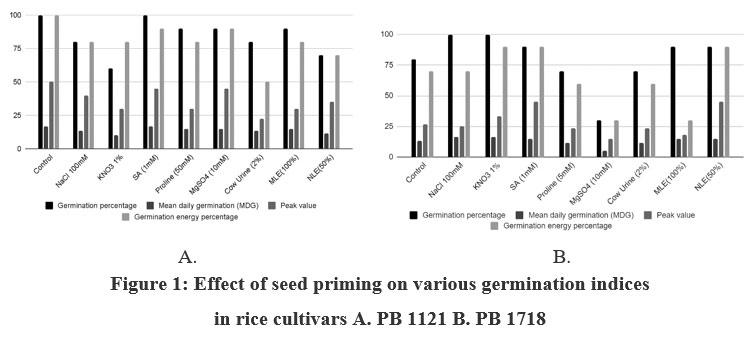 | Figure 1: Effect of seed priming on various germination indices in rice cultivars A. PB 1121 B. PB 1718.
|
Effect on growth parameters
In comparison to control, no significant increase in shoot length was observed in seeds subjected to various priming treatments in both rice cultivars (Fig 2, 3).
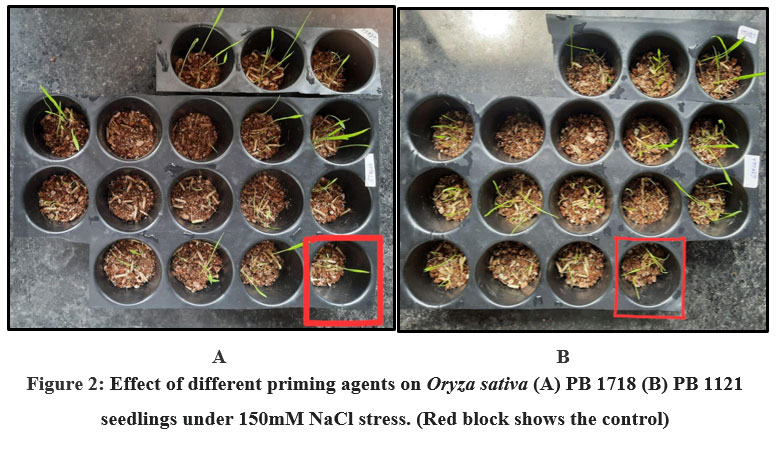 | Figure 2: Effect of different priming agents on Oryza sativa (A) PB 1718 (B) PB 1121 seedlings under 150mM NaCl stress. (Red block shows the control)
|
In cultivar PB 1121, an increase in root length was seen in seedlings treated with Salicylic acid (1mM), KNO3 (1%), Moringa leaf extract (100%) and Proline (50mM) (Fig. 3A). However, a significant increase in root length was observed in cultivar PB 1718 seedlings treated with NaCl, Salicylic acid (1mM), KNO3 (1%), Moringa leaf extract (100%) and Neem leaf extract (100%) (Fig. 3B). The increased root growth is important for enhancing water uptake and mineral acquisition.
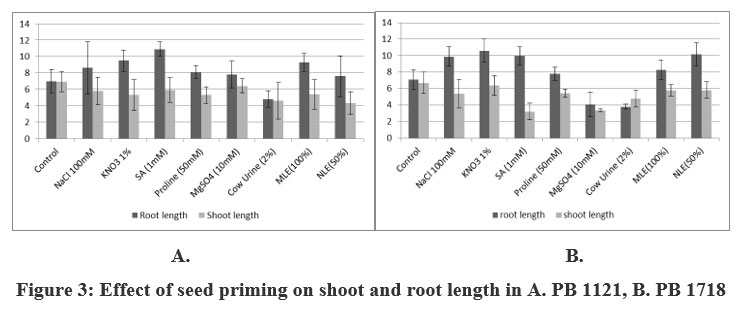 | Figure 3: Effect of seed priming on shoot and root length in A. PB 1121, B. PB 1718
|
In cultivar PB 1121, no significant increase was observed in fresh and dry weight in primed seeds(Fig. 4 A). In cultivar PB 1718 a moderate increase in dry weight was observed in seeds primed with MgSO4 (10mM), Cow urine (2%), Neem leaf extract (50%) and Moringa leaf extract (100%) (Fig. 4 B).
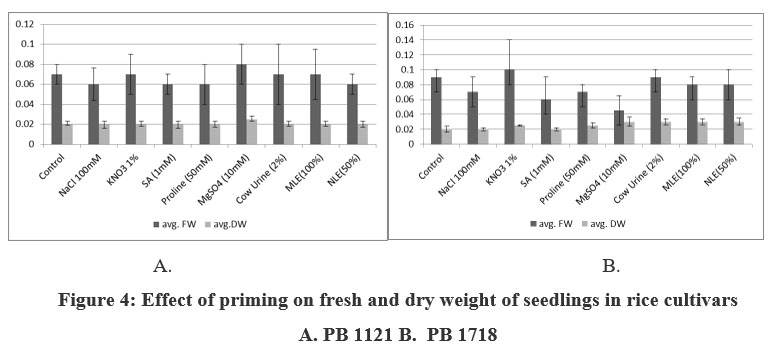 | Figure 4: Effect of priming on fresh and dry weight of seedlings in rice cultivars A. PB 1121 B. PB 1718.
|
Biochemical analysis
In cultivar PB 1121, an increase in total protein content was observed in seeds primed with Salicylic acid, Moringa leaf extract and Neem leaf extract (40% increase) (Fig. 5B). In cultivar PB 1718 slight increase in total protein was noted in Cow urine (8% increase) and NaCl (2% increase) as compared to control (Fig 5B).
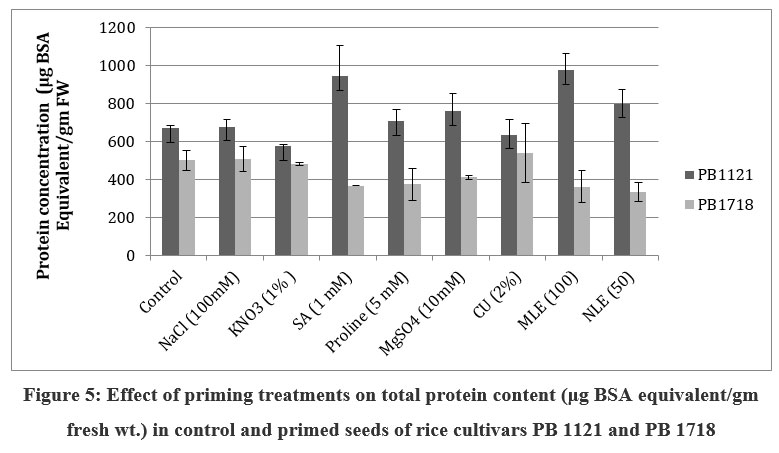 | Figure. 5: Effect of priming treatments on total protein content (ug BSA equivalent/gm fresh wt.) in control and primed seeds of rice cultivars PB 1121 and PB 1718
|
A significant increase of more than 30% was observed in total phenolics content (TPC) in cultivar PB 1121 in NaCl, KNO3, Salicylic acid, MgSO4 and Neem leaf extract priming treatments as compared to control (Fig 6). In cultivar PB 1718, 40 % increase in TPC was noted in KNO3 and 19 % in MgSO4 primed seeds as compared to control (Fig 6).
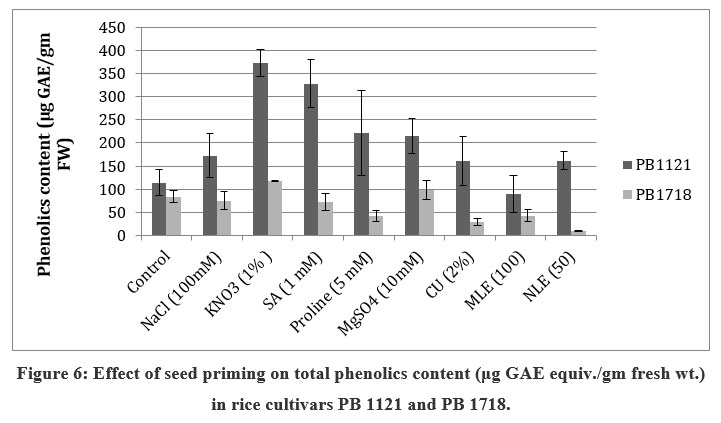 | Figure 6: Effect of seed priming on total phenolics content (ug GAE equiv./gm fresh wt.) in rice cultivars PB 1121 and PB 1718.
|
Analysis of antioxidant activity was done by DPPH assay. In cultivar PB 1121, three priming treatments were found to have a moderately higher % reduction than control. The highest % reduction was observed in seeds primed with proline [58.11 ± 4.54 %] followed by, salicylic acid [45.27 ± 18.36 %] and KNO3 [39.88 ± 9.60 %] as compared to control [38.29± 6.93%] (Fig 7). In cultivar PB 1718, all the priming treatments were observed to have significantly higher % reduction than control. The highest % reduction was observed in seeds primed with MgSO4 [77.82 ± 3.91 %], followed by NaCl [77.20 ± 4.59 %], Moringa leaf extract [74.77 ± 3.90 %], Cow urine [74.21 ± 5.37 %], KNO3 [74.38 ± 5.52 %] as compared to control [22.38 ± 2.51 %] (Fig. 7).
.jpg) | Figure. 7: Effect of priming on DPPH activity (% reduction) in rice cultivars PB 1121 and PB 1718
|
Discussion
In the present study, efficacy of different seed priming treatments was tested for amelioration of salt stress in two popular varieties of Oryza sativa. Out of the two cultivars that were tested, cultivar PB 1718 showed better plant growth and improved germination when subjected to priming treatment with Salicylic acid (1mM), KNO3 (1%), Moringa leaf extract (100%) and Neem leaf extract (50%) under salt stress of NaCl (150 mM). In cultivar PB 1121, no significant change was seen in germination indices under salt stress as compared to the control. However, this cultivar showed better root growth upon priming treatments with Salicylic acid (1mM), KNO3 (1%), Proline (50mM), Moringa leaf extract (100%), MgSO4 (10mM) and Neem leaf extract (50%).
KNO3 and Salicylic acid are reported to have a significant impact on emergence, seedling growth, and biochemical attributes as well as antioxidant properties of rice seedlings. KNO3 acts by maintaining ion homeostasis which is found to be essential for osmotic adjustment under salt stress. It facilitates membrane stability under stress, prevents chlorophyll degradation and regulates various physiological processes24. The application of salicylic acid accelerates the growth of cells by both division and elongation. It also helps in scavenging enzymes such as amylase, dehydrogenase and acid phosphatase in primed seeds by reactive oxygen species (ROS) and thereby stimulating seedling growth25. The Salicylic Acid pre-treatment also leads to the accumulation of various osmolytes, antioxidants and antioxidative enzymes to normal levels26.
Moringa and Neem leaves have been reported to facilitate cell division due to the presence of zeatin which is a natural cytokinin, in addition to minerals like potassium, calcium, magnesium, vitamin c etc27. Similar results involving seed priming with leaf extracts have been found to improve seed quality and overall yield in maize hybrids28. Priming treatments with MLE has been reported to improve photosynthetic pigment levels thereby promoting plant growth under stress conditions.
Conclusion
In the present study seed priming treatment of two popular rice cultivars (PB 1121 and PB 1718) showed promising results for overcoming salt stress with improved germination, seedling establishment and growth. The cultivars assessed showed variable responses towards different priming treatments. Out of the two cultivars assessed, PB 1718 exhibited robust seedling establishment upon priming treatments as compared to PB 1121. In cultivar PB 1718, priming treatments with KNO3 (1%), SA (1 mM), NLE (50%) and MLE (100%) resulted in better germination, growth and biochemical parameters, leading to improved alleviation of salinity stress. In cultivar PB 1121, Salicylic acid (1mM), KNO3 (1%), MLE (100%), MgSO4 (10mM), Proline (50Mm) and NLE (50%) treatments resulted in improved root growth. Therefore, the present study has the potential for developing cost-effective, easy-to-use, accessible and sustainable priming methods for overcoming salt stress in rice.
Acknowledgement
The authors gratefully acknowledge the financial support provided by Center for Research, Maitreyi College, University of Delhi.
Conflict of Interest
The authors declare no conflict of interest.
Funding Soureces
The project received financial support from the Center for Research, Maitreyi College, University of Delhi. under Summer Internship Program 2022.
References
- Wang Z, Zhang F, Zhang X et al. Quantitative evaluation of spatial and temporal variation of soil salinization risk using GIS-based geostatistical method. Remote Sens. 2020;12(15):2405.
CrossRef - IPBES. Summary for policymakers of the assessment report on land degradation and restoration of the Intergovernmental Science Policy Platform on Biodiversity and Ecosystem Services Scholes R, Montanarella L, Brainich A, Barger N, ten Brink B, Cantele M, Erasmus B, Fisher J, Gardner T, Holland TG, Kohler F, Kotiaho JS, Von Maltitz G, Nangendo G, Pandit R, Parrotta J, Potts MD, Prince S, Sankaran M, Willemen L, eds. IPBES Secretariat, Bonn, Germany; 2018.
- Kumar P, Sharma PK. Soil salinity and food security in India. Front Sustain Food Syst. 2020;4:533781.
CrossRef - Khan MA, Abdullah Z. Salinity–sodicity induced changes in reproductive physiology of rice (Oryza sativa) under dense soil conditions. Environ Exp Bot. 2003;49(2):145-157.
CrossRef - Singh V, Singh AK, Mohapatra T, S GK, Ellur RK. Pusa Basmati 1121-a rice variety with exceptional kernel elongation and volume expansion after cooking. Rice (N Y). 2018;11(1):19.
CrossRef - Liu L, Xia W, Li H et al. Salinity inhibits rice seed germination by reducing ?-amylase activity via decreased bioactive gibberellin content. Front Plant Sci. 2018;9:275.
CrossRef - Qin H, Li Y, Huang R. Advances and challenges in the breeding of salt-tolerant rice. Int J Mol Sci. 2020;21(21):8385.
CrossRef - Rahman. MA: Thomson; M.J; Shah E. M; De Ocampo, M; Egdane. Ala Med, J; Ismail AM. Exploring novel genetic sources of salinity tolerance in rice through molecular and physiological characterization. Ann Bot Lond. 2016;117:1083-1097.
CrossRef - Black M, Bewley JD, eds. Seed Technology and Its Biological Basis. Boca Raton: CRC Press; 2000.
- Bose B, Kumar M, Singhal RK, Mondal S. Impact of seed priming on the modulation of physico-chemical and molecular processes during germination, growth, and development of crops. In: Rakshit A, Singh HB, eds., Advances in Seed Priming. Berlin: Springer; 2018:23-40.
CrossRef - Hussain S, Ali B, Saqib M. Chapter 15. Seed priming to enhance salt and drought stress tolerance in plants: advances and prospects. In: Shanker AK, Shanker C, Anand A, Maheswari M, eds., Climate Change and Crop Stress. Cambridge: Academic Press; 2022:441-464. DOI: 10.1016/B978-0-12-816091-6.00012-2.
CrossRef - Singh H, Jassal RK, Kang JS, Sandhu SS, Kang H, Grewal K. Seed priming techniques in field crops -A review. Agric Rev. 2015;36(4). DOI: 10.18805/ag.v36i4.6662.
CrossRef - Lei C, Bagavathiannan M, Wang H, Sharpe SM, Meng W, Yu J. Osmopriming with polyethylene glycol (PEG) for abiotic stress tolerance in germinating crop seeds: a review. Agronomy. 2021;11(11):2194. DOI: 10.3390/agronomy11112194.
CrossRef - Afzal I, Butt A, Ur Rehman H, Ahmad Basra AB, Afzal A. Alleviation of salt stress in fine aromatic rice by seed priming. Aust J Crop Sci. 2012;6(10):1401-1407.
- Haider MU, Hussain M, Farooq M, Nawaz A. Optimizing zinc seed priming for improving the growth, yield and grain biofortification of mungbean (Vigna radiata (L.) wilczek). J Plant Nutr. 2020;43(10):1438-1446. DOI: 10.1080/01904167.2020.1730895.
CrossRef - Anosheh HP, Sadeghi H, Emam Y. Chemical priming with urea and KNO3 enhances maize hybrids (Zea mays L.) seed viability under abiotic stress. J Crop Sci Biotechnol. 2011;14(4):289-295. DOI: 10.1007/s12892-011-0039-x.
CrossRef - Ali, L.G., Nulit R, Ibrahim MH, Yien CYS. Efficacy of KNO3, SiO2 and SA priming for improving emergence, seedling growth and antioxidant enzymes of rice (Oryza sativa), under drought. Sci Rep. 2021;11(1):1-11.
CrossRef - Rahangdale P, Kumar A, Kumar R et al. Influence of biopriming and organic manures on growth, seed yield and quality of black wheat (Triticum aestivum L.). J Pharmacogn Phytochem. 2022;11(1):132-135.
- Theerakulpisut P, Kanawapee N, Panwong B. Seed Priming Alleviated Salt Stress Effects on Rice Seedlings by Improving Na+/K+ and Maintaining Membrane Integrity. Int J Plant Biol. 2016;7(1):6402. DOI: 10.4081/pb.2016.6402.
CrossRef - Lowry OH, Rosebrough NJ, Farr Al, Randall RJ. Protein measurement with the Folin phenol Reagent. Journal of Biological Chemistry. 193(1) 266-75.
CrossRef - Ainsworth EA, Gillespie KM. Estimation of total phenolic content and other oxidation substrates in plant tissues using Folin–Ciocalteu reagent. Nat Protoc. 2007;2(4):875-877.
CrossRef - Singleton VL, Orthofer R, Lamuela-Raventós RM. Analysis of total phenols and other oxidation substrates and antioxidants by means of Folin-ciocalteu reagent. In:. Methods in Enzymology. Cambridge: Academic Press. 1999;299.
CrossRef - Brand-Williams W, Cuvelier ME, Berset CLWT. Use of a free radical method to evaluate antioxidant activity. LWT Food Sci Technol. 1995;28(1):25-30.
CrossRef - Ali GL, Nulit R, Ibrahim MH, Yien CYS. Efficacy of KNO3, SiO2 and SA priming for improving emergence, seedling growth and antioxidant enzymes of rice (Oryza sativa), under drought. Scientific Reports. 11: 3864.
CrossRef - Roychoudhury A, Ghosh S, Paul S, Mazumdar S, Das G, Das S. Pre-treatment of seeds with salicylic acid attenuates cadmium chloride-induced oxidative damages in the seedlings of mungbean (Vigna radiata L. Wilczek). Acta Physiol Plant. 2016;38(1):11.
CrossRef - Theerakulpisut P, Kanawapee N, Panwong B. Seed priming alleviated salt stress effects on rice seedlings by improving Na+/K+ and maintaining membrane integrity. Int J Plant Biol. 2017;7(1):6402.
CrossRef - Khan S, Ibrar D, Bashir S et al. Application of Moringa leaf extract as a seed priming agent enhances growth and physiological attributes of rice seedlings cultivated under water deficit regime. Plants (Basel). 2022;11(3):261.
CrossRef - Kiran S. Evaluation of different organic and inorganic priming methods on seed quality parameters of Maize (Zea mays L.).






